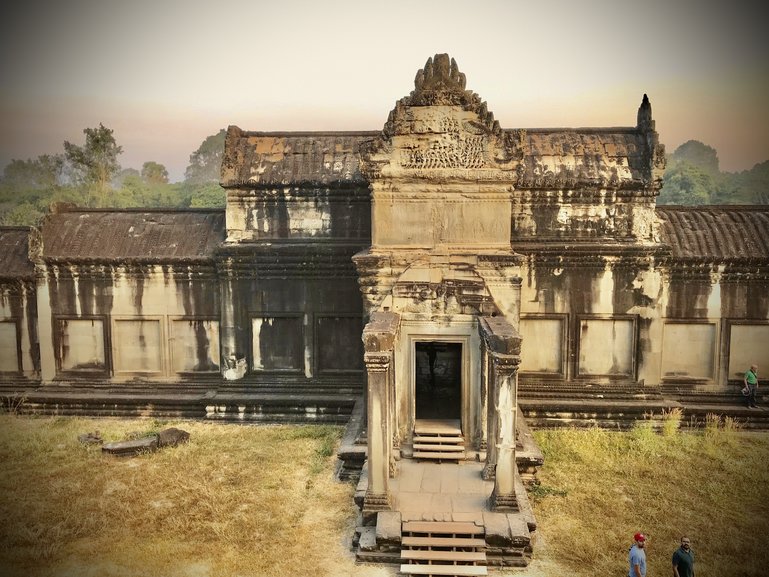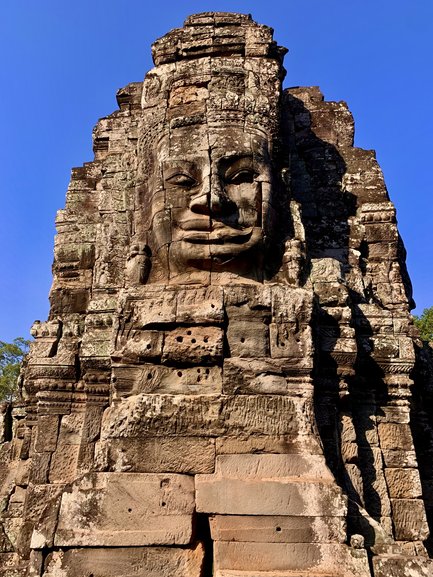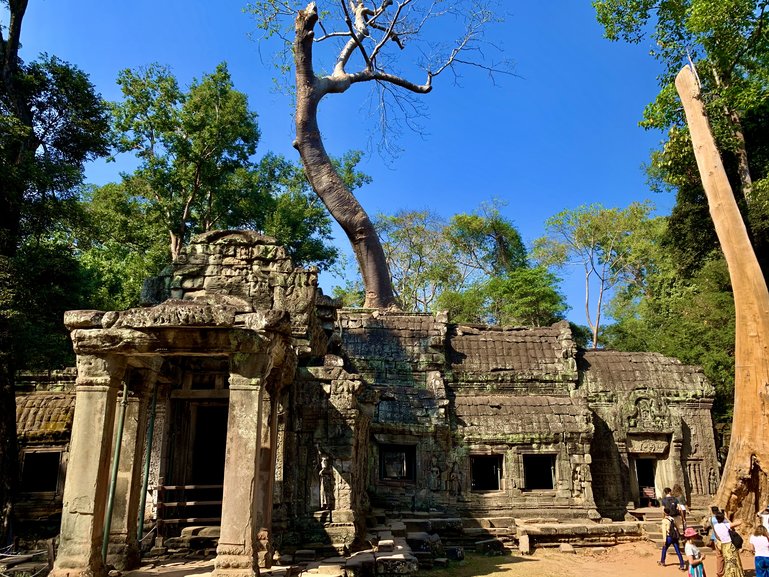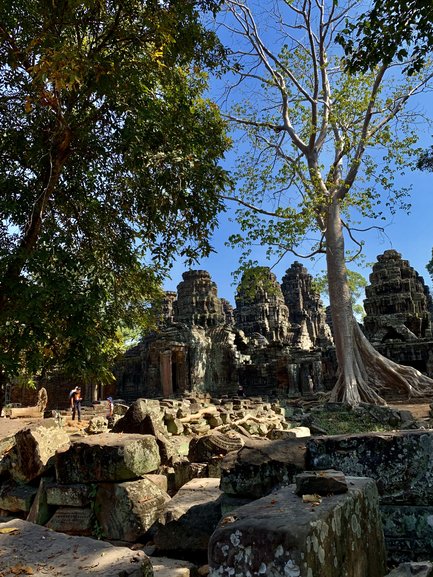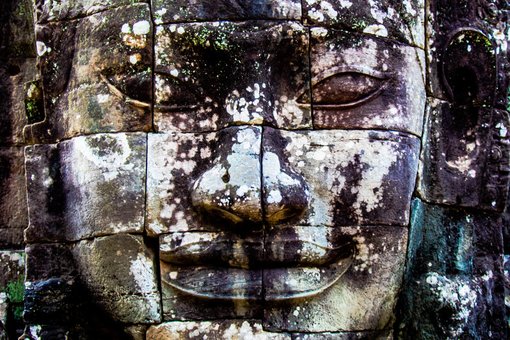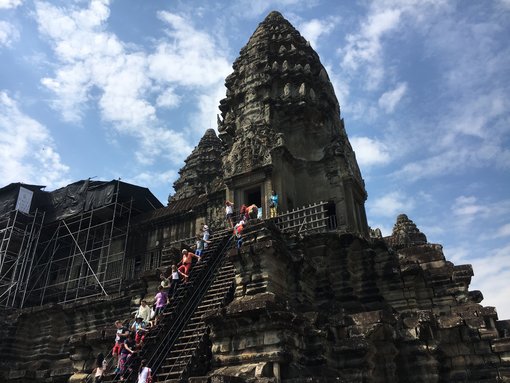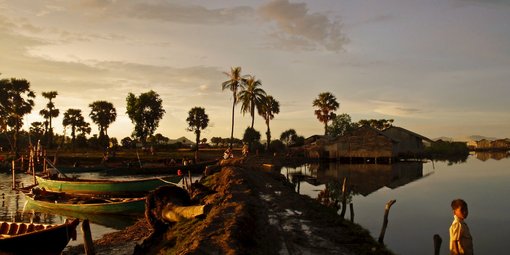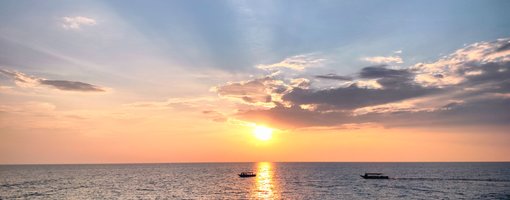I had always wanted to visit the temple of Angkor Wat after watching a documentary –The Lost City of the God Kings: Angkor Wat which I saw sometime in the year 2005. The documentary throws light on the Angkor civilisation that flourished in Cambodia between the 9th and 14th centuries. I was thoroughly intrigued by this largest religious monument of the world, a Hindu temple of Vishnu.
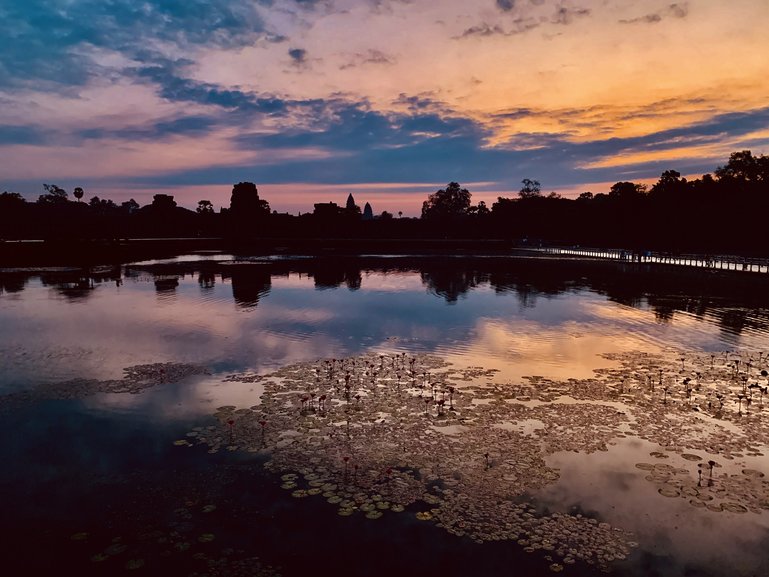
First view of Angkor Wat early in the morning
Then I forgot all about it until I watched the Hollywood movie Lara Croft:Tomb Raider. I was totally fascinated by this spectacularly beautiful temple entwined with ancient looking trees, which later I got to know was known as Ta Prohm temple, in Cambodia.
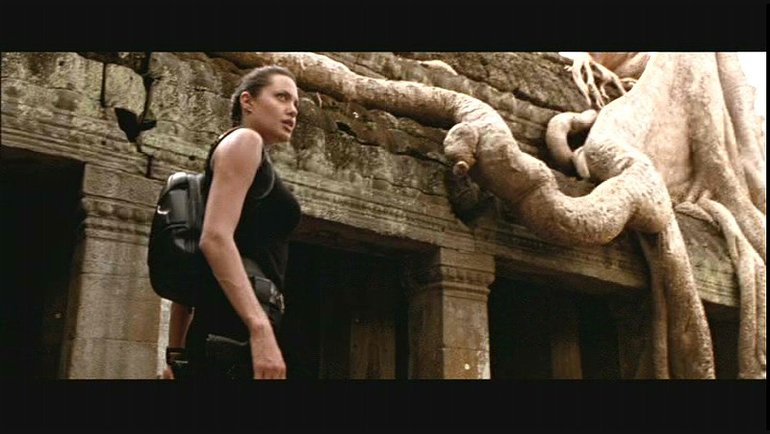
Lara Croft:Tomb Raider-The movie which made Angkor catch everyone's imagination
The movie rekindled my desire to go visit this fascinating place and finally I got the opportunity to visit it, after many many years in the month of December 2019, thankfully just before the COVID situation hit us and bought all travelling to a halt.
Reaching Siem Reap
The best way to visit Angkor Wat is to base yourself at Siem Reap City, since it is the closest to all Angkor attractions, and also one of the more developed cities in Cambodia.
You will find plenty of options to stay, right from expensive resorts to budget hostels. So it is one fine afternoon in December that we land at the Siem Reap International Airport. The check in process is smooth and the immigration officials are co-operative. You can check the visa requirements here.
Our pickup driver is there (arranged through the hotel) and the journey takes about 20 minutes. We are quite excited out our trip to Angkor tomorrow. The evening is spent at Pub Street, the most happening place of Siem Reap. We are looking forward to spend the next day at Angkor.
Reaching Angkor Wat
The best and easiest way to explore Angkor Wat and the temples nearby is the Tuk Tuk. Hiring it for a full day costs 25 USD while it will set you back by 15 USD if you hire it for half a day. I would suggest that go for the full day trip since it gives you more flexibility.
Our tuk tuk driver comes at around 4:30 AM to pick us up. He is a cheerful fellow and chatters nineteen to the dozen telling us about all the prominent temples which we would be seeing during the course of the day. Our first stop is the official ticket office.
Entrance tickets for Angkor
Entrance Passes cannot be bought online and can be purchased only at the official ticket office which opens at 5 AM in the morning and closes at 5.30 PM. There are long queues but the process doesn’t take much time. The ticketing person takes a picture of each visitor and prints it on the entry pass.
Passes are sold in one-day ($37), three-day ($62) and seven-day ($72) blocks that must be used on consecutive days. We opt for the one day pass since we have already decided the temples we wish to visit.
If you want to explore all the temples at leisure, it absolutely makes sense to go for the three day or seven day pass.
Travel Tips–In case you purchase the entrance pass after 5 PM, it can be used that same evening to view the sunset at Angkor Wat (Closing time 6 PM), included in your one day pass which is valid for the following day.
Wear appropriate clothing since this is a religious place. The weather is hot but tourists cannot enter sites without covering up the legs and shoulders. The local vendors charge a bomb for clothes which are needed for covering up.
*Also load up on the sun screen since it is really hot most of the days.*–Carry enough water as it is very very hot. Carry sunscreen. It is also very important to have good walking shoes since you have to walk a lot.
Exploring Angkor Wat
We are very excited about the sunrise at Angkor which everyone seems to be talking about. After buying our tickets, we go to Angkor. There is a slight nip in the early morning air and it is a pleasant ride till Angkor.The clouds however are playing hide and seek. This is the first view we get from far.
Well, we kind of miss doing the most touristy thing at Angkor, getting a shot of the famed sunrise! All because of the mischief of the clouds. There is pond where there are hundreds of tourists, all waiting for that one elusive shot of the sunrise. I still get to see something which is equally stunning in its own right, the reflection of the perfect symmetry of Angkor Wat in the pond. As fascinating as the ancient temple of Angkor Wat is, the history is equally fascinating.
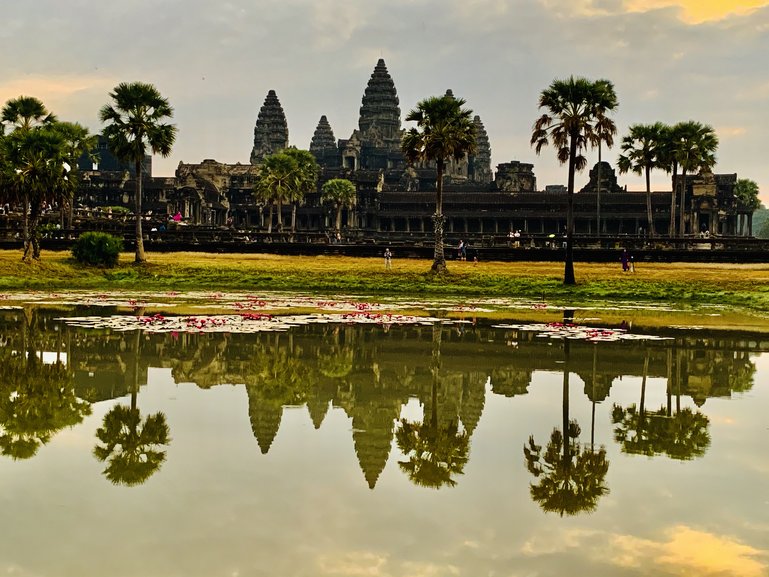
The perfect reflection
An architectural marvel, rich in details and also the largest religious monument in the world, Angkor Wat was built in the early 12th century (between 1113 and 1150) during the reign of King Suryavarman II, both as a capital and a State Temple, dedicated to Lord Vishnu.Approximately 27 years after the death of King Suryavarman II, in 1177, Angkor was sacked by the Chams, the traditional enemies of the Khmer. Thereafter the empire was restored by King Jayavarman VII, who established a new capital and state temple of Angkor Thom and Bayon, respectively a few kilometres to the north.
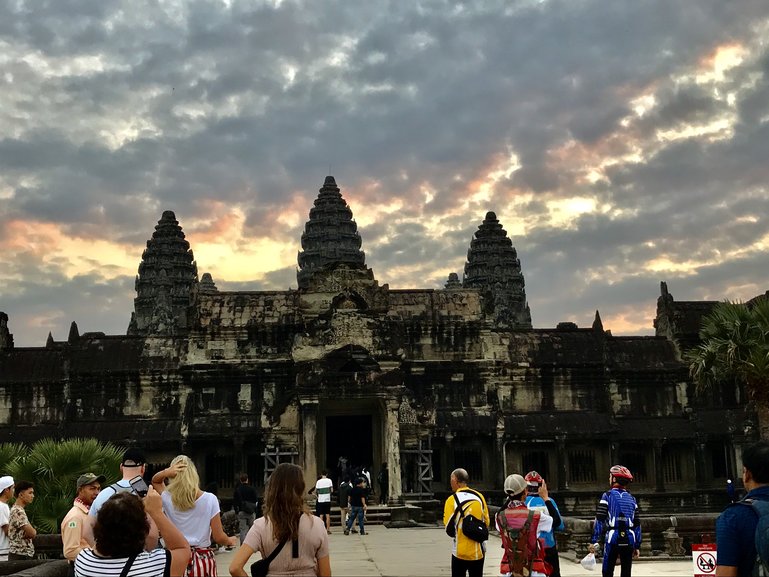
Angkor Wat
Angkor was, for centuries, the capital of the ancient Khmer Kingdom and was constructed in a very planned manner, with magnificent and impressive monuments, large water reservoirs and urban plans, all pointing towards the existence of a developed civilisation.The temple is designed to represent Mount Meru, home of the devas in Hindu mythology. Within a moat more than 5 kilometres (3 mi) long and an outer wall 3.6 kilometres (2.2 mi) long are three rectangular galleries, each raised above the next.
The total area of the temple is almost 200 hectares and the temple has the two main features of Khmer architecture-pyramid and concentric galleries. The temple is a pyramid of three levels, each level enclosed by a gallery with four Gopuras. The summit is crowned with five towers in a quincunx.
Hinduism dominated the Khmer Empire until the end of the 12th century after which Mahayana Buddhism came in, for a short while. Though both the religions came from India, it is most likely that the Indian traders were the first to introduce Hinduism to Cambodia. By the time Khmers adopted Hinduism, there were two principal cults- of Shiva and Vishnu.
A French naturalist by the name of Henri Mouhot rediscovered the palaces and temples hidden inside the forest at the end of the 19th century. In the year 1992, the whole territory of Angkor was taken under the protection of UNESCO.
We end up spending a lot of time at Angkor and its worth every minute. I feel struck by the this remarkable architectural marvel and its sheer size and sculptures. I feel like I have stepped into history in real time. The place is well-preserved and that is amazing considering how old the structure is!
Angkor Tham
Angkor Tham is one of the largest of all Khmer cities and was constructed in the late 12th century.I am stunned by the majestic South Gate with its towers pointing in each of the cardinal directions and elephants, preceded by the no less impressive avenue of Gods and Asuras lining the bridge across the moat. Angkor Thom complex has the Bayon Temple which is recognized as the temple of faces.
The Bayon
Though Angkor Wat is the most famous amongst all the temples, I am somehow totally taken in by the magnificence of the grandeur of the 12th century AD Bayon Temple within the walled city of Angkor Thom.The Bayon is the only Angkorian state temple to be built primarily as a Mahayana Buddhist shrine dedicated to the Buddha and has around 216 calm and smiling stone faces all over the temple.
The similarity of the 216 gigantic faces to other statues of the king has led to the conclusion that the faces depict King Jayavarman VII himself.Another theory says that the faces belong to the bodhisattva of compassion called Avalokitesvara or Lokesvara. Whatever or whoever they may be depicting, the faces are unique and seem to create a Stone Mountain of ascending peaks.The Bayon is definitely an amazing temple with its unique architecture.
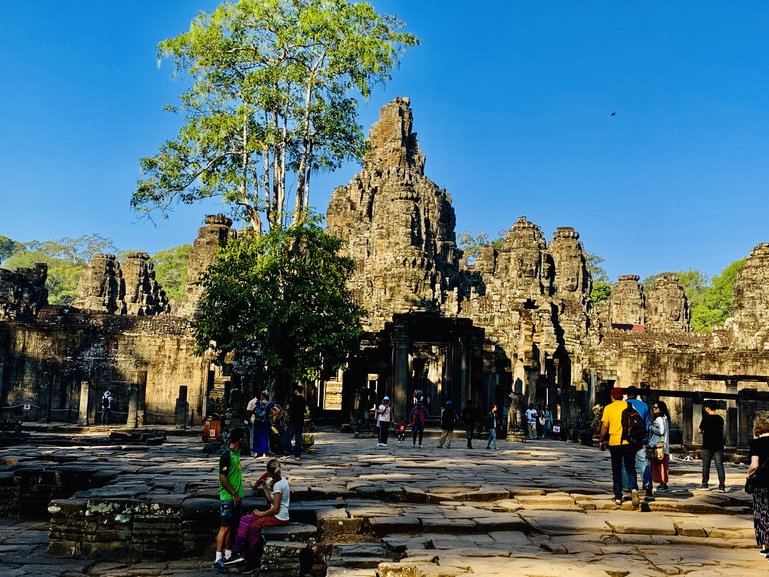
Bayon Temple
Ta Prohm
One of the reasons I always wanted to visit Angkor because of the Ta Prohm temple shown in the movie Lara Croft:Tomb Raider.The city of Ta Prohm was founded as a Buddhist Monastery and university and was home to more than 12,000 people according to historians. The temple was abandoned after the fall of the Khmer Empire in the 15th century.Though I knew about the temple through the movie, but even if it wasn’t a part of a movie, it still merits a visit because of its picturesqueness. This is one of the few temples which has merged with nature beautifully.
Banteay Kdei
Banteay Kdei, the last major temple we visit, is known to be a mysterious temple with no record of why it was built or by whom it was built. There are no inscriptions on the site.
Known as the ‘Citadel of Monks’ or ‘Citadel of Chambers’ , this temple was built in the late 12th to early 13th Century during the reign of Jayavarman VII.This temple is not so crowded and you can spend some time here appreciating the amazing frescos of of female deities found in Hinduism and Buddhism.
Choose the itinerary best for you
Two types of itineraries are available wherein you can choose one depending on the time you have and the sites you wish to explore.
Grand Circuit 26km
The grand circuit (26 Kms) is a good way to explore the famous as well as the lesser known sites. It covers Preach Khan, thought to be a University earlier and Phnom Bakheng, a great place to watch a sunset
Small Circuit 17 km
The Small Circuit (17 Kms) is quite popular with the tourists and is a great way to explore the most prominent sites of the Angkor. It covers Angkor Wat, Angkor Thom (Bayon), Thommamon, Chau Say Tevoda,Ta Keo, Ta Phrom, Banteay Kdei and Srah Srang.
I would suggest to opt for the small circuit tour when you just have a day at hand so that you can appreciate the beauty of the temples and not make it a very rushed affair!
Angkor is a place you will fall in love with!




